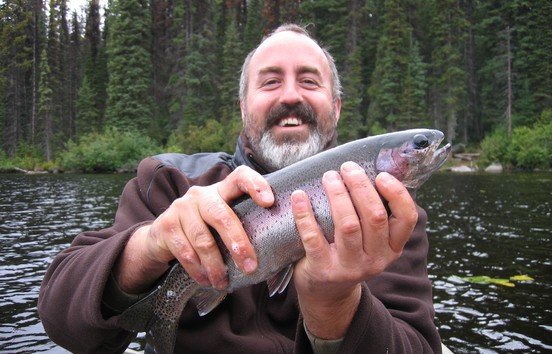Freshwater Fishing in British Columbia – by Brian Chan
During your freshwater fly fishing trip in BC , it is always best to have a good understanding of the fly fishing equipment and tactics that are successful on the waters you will be visiting. In BC, and certainly in the lakes around Caverhill, almost all fly fishing is done from boats or from some form of fly fishing craft. In most instances, lake bottoms are too soft for wading and often the best fly fishing areas cannot be reached from shore. Ten to twelve foot long wooden, aluminum or fiberglass boats setup with oars are ideal for these small stillwaters. Another essential item is anchors, preferably two, that can be deployed off the bow and stern of the boat so that it stays in one position despite changing wind directions. This is really important when there are two anglers in the boat trying to control casts and retrieves.
The ideal fly rod for BC freshwater fly fishing is between nine and ten feet in length and matched to a 5 or 6 weight fly line. Longer rods allow better control of the cast as much of the fishing is done from the sitting position in a boat. As well, it makes it easier to cast the longer leaders often used with floating lines.
The majority of our freshwater fly fishing is done in shallow water, generally from 5 to 25 feet in depth. The 25 foot depth marks about the maximum extent of sunlight energy penetration which is critical to the overall productivity of a waterbody. Aquatic plant life is dependent on photosynthesis so will only grow where the light’s energy can penetrate to the lake bottom. Aquatic plant life provides the habitat for the many invertebrate food sources including aquatic insects that trout feed on.
Several different fly lines are required to effectively cover the various depth zones of water that the trout may be feeding in, as well as to imitate the movement of particular food sources. A floating line is needed to present the adult imitations of midges or chironomids, mayflies, caddis flies and damselflies as they sit or get trapped on the surface of the lake. A floating line used in combination with varying leader lengths and with or without strike indicators can be extremely effective in presenting a variety of sub-surface imitations such as scuds, bloodworms, chironomid pupae, mayfly nymphs, caddis pupae and damselfly nymphs. Weighted flies or adding weight to the leader will help get the fly down to the lake bottom. In most instances “Nymphing†or using a floating line and sinking leaders means trying to present patterns as close to the lake bottom as possible. The rule of thumb for floating line nymphing is to make sure the leader is at least 25% longer than the depth you are fishing. For example, if we are anchored in 10 feet of water and fishing mayfly nymphs with a floating line then the leader needs to be at least 12 to 13 feet in length. The longer leader is necessary because as the fly is retrieved the leader will be on an angle. If it is not long enough the fly will not stay near the bottom of the lake which in most in instances is where the actively feeding fish will be found.
A slow sinking fly line is very effective in fishing leeches, mayfly nymphs, caddis pupae, damselfly nymphs and water boatman and dragonfly nymphs. Slow sinking lines sink at a rate of 1.5 to 2 inches/second. This slow sinking nature allows flies to be retrieved on a very gradual angle off the lake bottom towards the surface of the lake which imitates well the natural movement of the insects or other food sources. Leaders should be between 9 and 12 feet in length when using this line.
A fast sinking fly line (Type III or IV) is also an important part of your tackle bag when fishing stillwaters. These lines sink at between 3 and 5 inches/second and are an excellent choice when fishing water boatman or backswimmers, fishing the edges of drop-offs or for trolling leeches, dragonfly nymphs and other searching style fly patterns. Leaders should be between 9 and 12 feet in length.
Anglers should always carry tippet material so that leaders can be rebuilt or lengthened as required. Extra spools of 3X, 4X and 5X will cover off all the fishing situations one may encounter in these lakes. Fluorocarbon leaders and tippet material have several advantages over monofilament including smaller diameter, less visible in water and stronger so you may want to consider having some in your gear bag. Just remember not to use it when fishing dry flies as it is stiffer and sinks much faster than monofilament.
Come to Caverhill Lodge and enjoy your next fly fishing vacation!
As I snack on the smoked trout (in between the bones…), I’ll think of Caverhill and how relaxing it was to be there.
There are a dozen or more lakes surrounded by low hills on a high plateau near Wells Gray Prov. Park, and Larry has built great, well-marked trails between them.
There are many lakes and they are all great fishing.






